Time limits and wind limits, this could go on for awhile. The score is 8 to 2 in favor of the New Zealand team. Match point and deuce.
Category: america’s cup 34
WIND LIMITS
Today a cold front is headed towards San Francisco, It certainly looked this morning that is was moving faster than forecast. I do not believe that any races will be sailed today. The following is an interesting explanation as to why the wind limits are in place.
Today
UPDATE: 1130 hours
Races 13 and 14 are on the slate today, scheduled to start at 1315 and 1415 respectively. With a cold front approaching the Northern California region today’s weather is a bit unstable. The front was forecast to increase winds tonight, but that build has started earlier than expected.
The original forecast called for winds of 10 to 15 knots with clouds increasing throughout the afternoon. But Regatta Director Iain Murray says the wind is already building.
“It’s getting windier than that on racecourse. Already it’s blowing 15-18 knots at Anita Rock, in the sheltered part of San Francisco Bay, and more than that on Treasure Island,” said Murray.
High tide in San Francisco is scheduled for 1249, which means there’ll be a slight increase in the base 23-knot wind limit for Race 13 (23.3 knots) and then a decrease for Race 14 (21.3 knots).
“Were expecting the breeze to build all day and be very windy tonight,” Murray said. “We were confident of getting some races in on the earlier forecast, but the reality of what we see out there on the racecourse, it is windier – and this is pre-frontal as front comes through – we’ll have to play it by ear.”
As for the teams, ORACLE TEAM USA was issued another certificate again this morning, its 13th in 13 races. A new certificate has to be issued for the slightest of changes, such as moving the rudderhead 10 millimeters, so it’s not surprising that the defender has constantly changed its boat in the search for the perfect setup. Today, the most notable change was the addition of the bowsprit, perhaps due to the original light-wind forecast.
Emirates Team New Zealand will have port tack in the Race 13 pre-start and ORACLE TEAM USA will be on port in Race 14.
FROM SAILING ANARCHY:
I cracked the books a bit and ran some numbers yesterday. I think I have a good reason for the wind speed limit being set where it is. Wow was I wrong. The boats ended up being faster than they predicted, i.e. the designs were too good. ![]() This put them dangerously close to putting the foils into cavitation speeds (~50+) that could have lead to real control problems.
This put them dangerously close to putting the foils into cavitation speeds (~50+) that could have lead to real control problems.
Basically they want to limit boat speed to under 50 knots to stay safely out of foil cavitation speeds. The boats can sail over 2x wind speed and in some ranges are close to or at 3x wind speed the TWS needed to keep them below 50 knots is in the 22-24 knot range.
The wind limit for safety was not a reaction to the Artemis disaster as I assumed incorrectly. I had assumed the limit was for structural concerns not an unforeseen design challenge.
If they want higher wind speed limits they have to lose the foiling to remove the “50 knot barrier” or they can lose the wing to reduce the top speed of the boats to under 3x wind speed.
If they want to keep the full foiling and hard wings they are stuck with a low wind speed limit until they solve the cavitation issue. Sort of ironic that the faster the boat is relative to wind speed the lower the safe wind speed becomes. If indeed the wind limit was lowered due to concerns about foil cavitation then they got it right and the engineering math supports it.
It is not about being pansies, or poor design, or reaction to the Artemis disaster. It is about unforeseen design success.
Stop bitching about the boats being to fragile to sail in 30+
Start celebrating that they are too fast to sail in over 25.
I’m surprised that none of the SA techies from AC33 had done the figures to reach this conclusion.
Cheers,
THERE IS NO TOMORROW
Yesterday’s start should not have surprised anyone. Team New Zealand did not want to get into foul trouble so they may have been over cautious. Oracle had nothing to lose (still don’t). There only hope was reckless abandon (still is). They must approach each race as if there is no tomorrow. This seems to fit Jimmy Spithill’s personality.
ONE AND DONE?
Emirates Team New Zealand on precipice of winning 34th America’s Cup
Emirates Team New Zealand’s wire-to-wire win in Race 11 moved the challenger to match point in the 34th America’s Cup against defender ORACLE TEAM USA.
About 38 minutes later, as the two crews were jockeying for position on the start line of Race 12, the race committee postponed the sequence because the wind strength had exceeded the prescribed 20-knot limit, forcing the Kiwis to wait until tomorrow for a chance to close out the series.
Emirates Team New Zealand leads ORACLE TEAM USA 8-1 on the scoreboard, with the winner the first to score 9 points. The Kiwis need just one more victory to win the America’s Cup for the third time (1995, 2000), while ORACLE TEAM USA needs to win eight consecutive races to defend the trophy it won in 2010.
“It’s not over; it’s a long way from over,” said ORACLE TEAM USA skipper Jimmy Spithill. “Both teams would’ve liked to sail the second race, but Iain (Murray, Regatta Director) has to stick by the limits that are set.”
Race 11 didn’t feature the breathtaking back-and-forth lead changes that were a hallmark of Sunday’s Race 10, but it was every bit as exciting for the close-quarter action. Emirates Team New Zealand led at all four mark roundings – by 3, 6, 17 and 18 seconds – before settling for a 15-second victory.
Barker did a good job in the pre-start, setting up to leeward of ORACLE TEAM USA. Both crews were late to the start line, mainly because Barker was holding the match up, slowing the defender until he was ready to rip onto the racecourse.
The 3-nautical-mile upwind leg again proved pivotal to the match. The Kiwis began the leg with a 6-second advantage, but ORACLE TEAM USA once again attacked. The two crews traded 10 tacks on the leg, but the Kiwis fended off every advance with covering tactics and solid boatspeed.
On the run to the final turning mark ORACLE TEAM USA closed up to Emirates Team New Zealand’s transom, but the Kiwis were able to sail a low course to round the mark, albeit at very slow speeds, while the defender had to put in two maneuvers to get around the mark. That gave the challenger enough breathing room on the final leg to the finish.
“Every win here is so hard, they’re monumental battles, so you’re thankful for every win you get,” said Barker. “We had a bit of an idea how to attack it and it worked out as well as it could have. We had a nice little jump, sailed a good first run, at the bottom mark another split and backwards and forwards after that. We were happy to sneak away with another win.”
Emirates Team New Zealand gets two chances tomorrow to close out the series. Race 12 is scheduled to start at 1:15 pm PT, followed by Race 13 (if necessary) at 2:15 pm PT. The wind is forecast to be similar to today, light to moderate for the first race and building for the second race. The lighter conditions seem to suit the Kiwis more than ORACLE TEAM USA.
“The boat seems to go well in a breeze, that’s obvious,” said Spithill. “But I think we can still win races in the light stuff. We’re looking hard every night at what we can do. We’d love to get on with the racing, but we’ve got those wind limits and have to obey them. Whatever the conditions are we’ll go into it 100 percent.”
In the U.S., the America’s Cup Finals will be broadcast live on the NBC Sports Network. Replays will be available on the America’s Cup YouTube channel.
Internationally, the America’s Cup Final can be viewed in more than 170 territories. All racing is also live on America’s Cup YouTube channel (subject to territorial restrictions).
You can also follow racing with America’s Cup App for android and iOS devices.
—Sean McNeill
34th America’s Cup Standings (first to 9 points wins)
- Emirates Team New Zealand – 8
- ORACLE TEAM USA – 1
Race 11 Performance Data
- Course: 5 Legs/10.16 nautical miles
- Elapsed Time: ETNZ – 23:41, OTUSA – 23:56
- Delta: ETNZ +:15
- Total distance sailed: ETNZ – 11.7 NM, OTUSA – 11.5 NM
- Average Speed: ETNZ – 29.88 knots (34 mph), OTUSA – 29.04 knots (33 mph)
- Top Speed: ETNZ – 44.57 knots (51 mph), OTUSA – 42.70 knots (49 mph)
- Windspeed: Average – 15.4 knots, Peak – 18.0 knots
- Number of Tacks/Jibes: ETNZ – 10/6, OTUSA – 10/8
Upcoming America’s Cup Schedule
- Thursday, Sept. 19: Race 12 (1:15 pm PT), Race 13* (2:15 pm PT)
- Friday, Sept. 20: Race 14* (1:15 pm PT), Race 15* (2:15 pm PT)
- Saturday, Sept. 21: Race 16* (1:15 pm PT), Race 17* (2:15 pm PT)
- Sunday, Sept. 22: Race 18* (1:15 pm PT), Race 19* (2:15 pm PT)
(*If necessary)
WEDNESDAY COULD BE THE DAY?
Preview: Wednesday could be the day
 After today’s postponement the wind conditions look to be lighter for Wednesday and should allow for racing to begin as scheduled at 1:15 pm PT. Races 11 and 12 are on the docket and if Emirates Team New Zealand sweeps both it’ll win the America’s Cup for a third time.
After today’s postponement the wind conditions look to be lighter for Wednesday and should allow for racing to begin as scheduled at 1:15 pm PT. Races 11 and 12 are on the docket and if Emirates Team New Zealand sweeps both it’ll win the America’s Cup for a third time.
The Kiwis lead the America’s Cup Finals 7-1 over ORACLE TEAM USA. The first team to reach 9 points will hoist the Cup.
The forecast is for winds between 14 and 17 knots, potentially gusting higher later in the afternoon. That could be the lightest average wind in this final series, and might produce different results.
“At the moment we look good in higher winds and maybe they look better in lower winds, but that might change in the next few days,” said ORACLE TEAM USA designer Dirk Kramers, at a media briefing following the postponement.
The defender looks better in higher winds due in part to the series of modifications it undertook last Friday in the quest to improve upwind performance.
Kramers was coy in his explanation of the improvements. “The obvious changes were we went to the short spine (bowsprit). There were probably four or five more changes, all visible to the naked eye. So I challenge you to find them.”
Emirates Team New Zealand designer Nick Holroyd picked up the conversation from there. “I think there’s been some rake change in the wing, beyond that where they’ve taken the spine structure away saves you a bunch of weight, which opens up opportunities to do things elsewhere. But I’ll go back and terrorize the recon department to find more,” said Holroyd.
A strong ebb (outgoing) tide will lower the wind limits to 21 knots for the first race on Wednesday and 20 knots for the second race. Although the low limits were a hindrance to racing on Tuesday, the ebb tide serves to open up the racecourse, and if the wind is as forecast, shouldn’t cause a postponement.
“We’ve seen the game change drastically from very one-sided track in flood (incoming) tides with good control to having an open racecourse,” said Holroyd. “The way the guys are thinking on the boat has to change quickly.”
The two designers spoke this afternoon following the postponement of racing. They both agree that working on the AC72 design development has been the most fun challenge they’ve undertaken.
“Essentially we’ve taken a two-dimensional sport and made it three dimensional, and it’s pretty fun,” said Holroyd.
“Something similar to this is the future,” said Kramers. “As far as pure spectacle this is great, and we might not see it again.”
I agree that the spectacle is unprecedented. From what I have seen during the races, Until two days ago I felt Oracle was faster in light air. Without a doubt Oracle upped their game during races 9 & 10.
LOST OPPORTUNITIES?
Opportunity lost by America’s Cup Defender
With four races scheduled last weekend, America’s Cup challenger Emirates Team New Zealand was expected to seal their victory of the 34th Match. What happened instead was that defender Oracle Team USA won two of three (fourth race was abandoned due to wind limit), but the American team could have arguably won all three. Here’s the set-up:
On the upwind leg of Race 10, the challenger was on the left side of the course, already on port tack and on layline to the north (right) gate. The defender was on the right side of the course, had just tacked to starboard and were on layline to the south (left) gate. The teams were even; the challenger would have to duck.
Here is the broadcast commentary from the video replay (at around 1:41:20):
Ken Read: “Emirates Team New Zealand is going high and slow right now, looking for a dip at the last second. They want to dip and still be able to lay this gate.”
Gary Jobson: “With that tactic, Oracle needs to slow down.”
But Oracle didn’t slow down. They allowed the Kiwis an easy dip, and both teams then rounded the opposite gates at near the same time. The Kiwis went on to win the race.
Ron Young, who was General Manager of the Golden Gate Challenge for America’s Cup 1987, points out the mistake. “Had Oracle done something similar to tactically slow their starboard tack ‘right-of-way’ course, New Zealand (on port tack and thus burdened to ‘keep clear’) would have had no choice but to duck behind Oracle while she was in the ‘circle’ and blocking the north end of the gate. This maneuver would have forced the Kiwi’s north of the gate. Once north of (and missing) the gate, New Zealand would’ve had to tack (or possibly gybe) to follow Oracle around the south end of the gate – likely over than five boat lengths behind Oracle.”
Another option was for Oracle to bear away and aim at the Kiwis, which would have also led to the challenger falling below layline. But this action would have been limited by the ISAF Racing Rules of Sailing – America’s Cup Edition. In Rule 16 (Changing Course), it states that “When sailing to a mark that is to windward, a starboard-tack yacht shall not bear away to a course that is below her proper course and more than 60 degrees from the true wind direction if at that moment the port-tack yacht that is keeping clear by sailing a course to pass astern of her has to immediately change course to continue keeping clear.”
Other options include how Oracle could have tacked in front of New Zealand, which they were entitled to do under the America’s Cup Racing Rules, because they were the inside boat and entitled to sail their proper course around the mark. They also may have been stronger if they were on the starboard layline to the north (right) mark.
The other thought in this is that Oracle had chosen to round the south (left) gate mark, so this discussion is premised on the fact that in hindsight the north (right) mark was preferred, which is often the case due to more breeze offshore, better apparent wind speed due to sailing into the ebb which increases the boatspeed more than the adverse affect of the current, and of course, the starboard advantage if there were a close crossing downwind, as there was.
Bottom line is the defender had the starboard advantage, but did nothing with it.
FROM SCUTTLEBUTT
JUST WHEN I THOUGHT IT WAS ABOUT THE SAILING
America’s Cup: Kiwis take official’s cheating claim to Cup jury
By Paul Lewis
Emirates Team New Zealand are taking action against Golden Gate Yacht Club vice-commodore Tom Ehman under the same regulations that saw the America’s Cup international jury penalise Oracle Team USA two points in the cheating saga.
Ehman made his own veiled claims of cheating to a journalist from the Independent in London. But Team NZ have rejected the claim and were preparing an application to the jury under the same Article 60 of the protocol (bringing the Cup into disrepute) and Rule 69 of the rules of sailing (gross misconduct) as were taken against Oracle.
Golden Gate is the club hosting the defence of the America’s Cup on behalf of holders Oracle. Ehman (who is also director of external affairs for the America’s Cup Events Authority) complained of Team NZ’s radio system connecting to tactician Ray Davies and said Oracle did not have the same thing.
He reproduced a quote first used by America’s Cup icon Dennis Conner in 1986 (he was complaining that New Zealand’s “plastic fantastic” fibreglass yacht was cheating and said, “Why would you [build in fibreglass] if you didn’t want to [cheat]).” All the other yachts were made of aluminium.
Asked if he knew what he was saying in using the same quote, Ehman told the Independent: “Yes.”
Regatta director Iain Murray told the newspaper he had inquired into the allegations and felt Team NZ were not cheating. Both teams had radio systems that connected to their boats but they had to be turned off during the race and couldn’t be used again until the race was called off.
Oracle’s original complaint, from rules adviser Richard Slater, alleged that coach Rod Davis had communicated with tactician Ray Davies while a race was still in progress. But radio contact was initiated only after race director Harold Bennett could not contact the boat to advise that Race 9 had been called off on Sunday for excessive wind. Team NZ chief Kevin Shoebridge, not Davis, then relayed the message.
That led Oracle to question the Kiwis’ use of the system, querying whether it was in breach. However, Ehman’s claims went further than that, with the veiled reference to cheating, and Team NZ decided to take the matter to the jury.
Just when I thought that it was all about the sailing. I do not believe that this will amount to anything; but what do I know?
RACES 9 & 10 AMERICA’S CUP
AMERICA’S CUP DAY 6
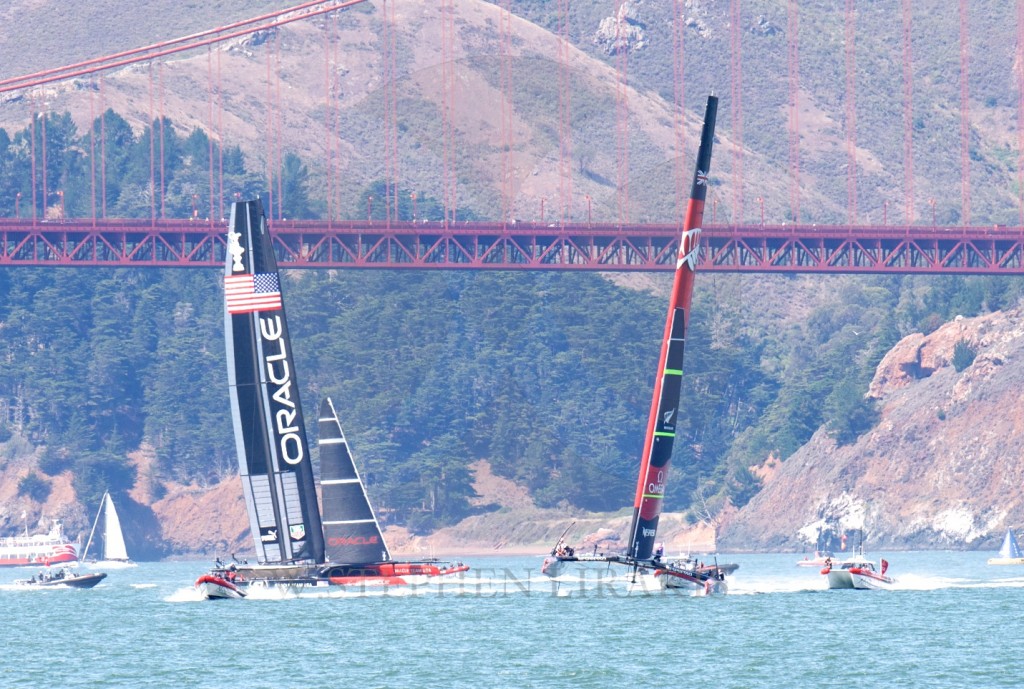
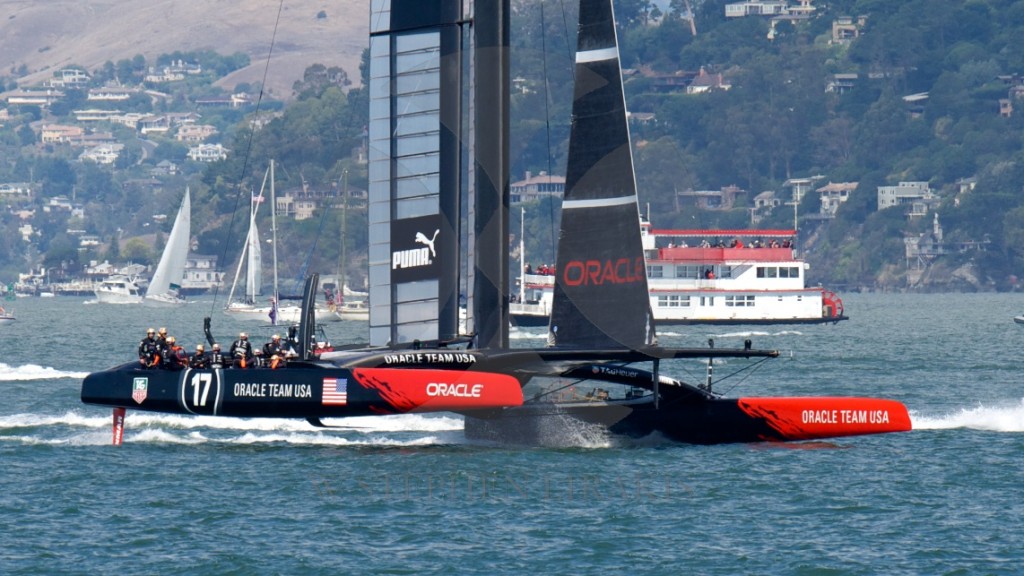
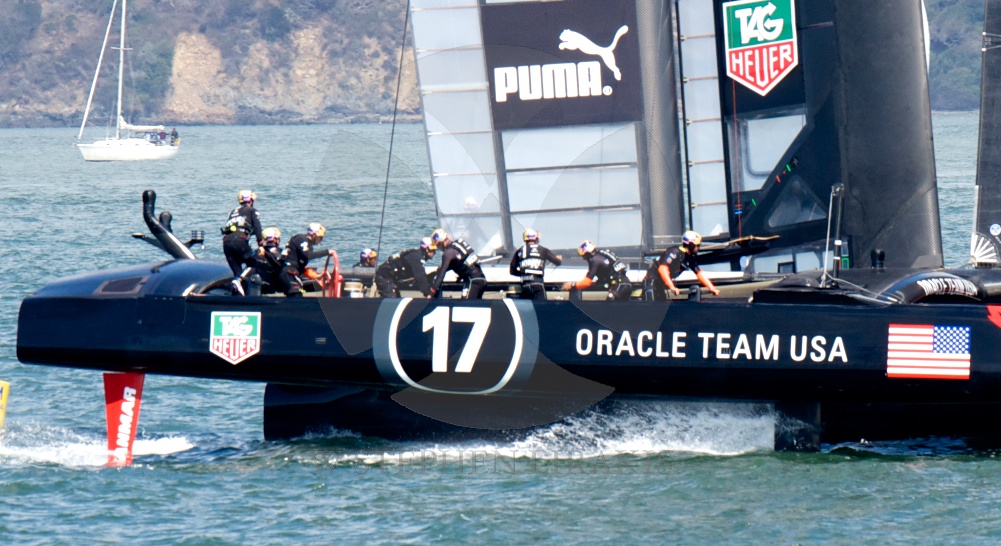
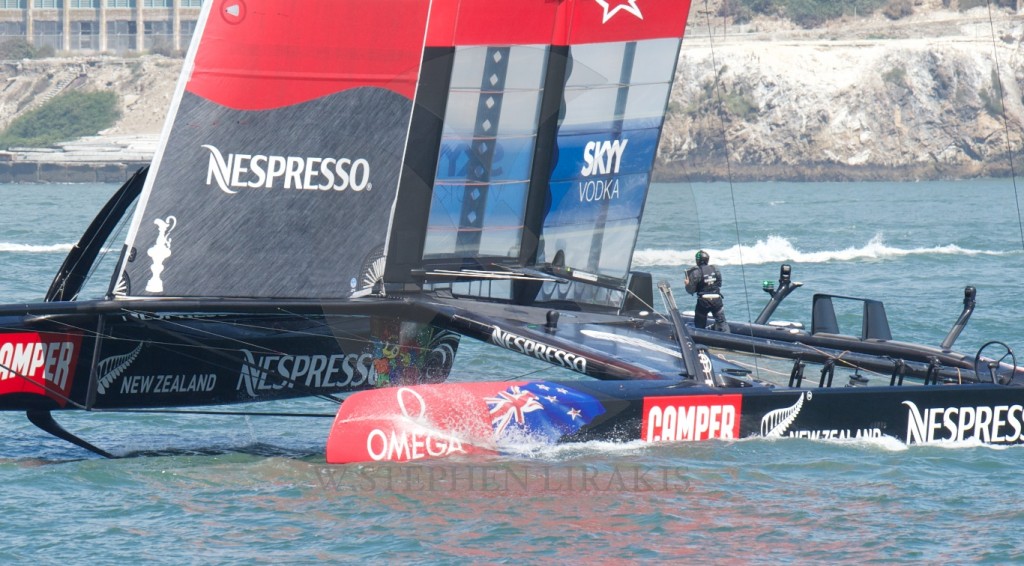
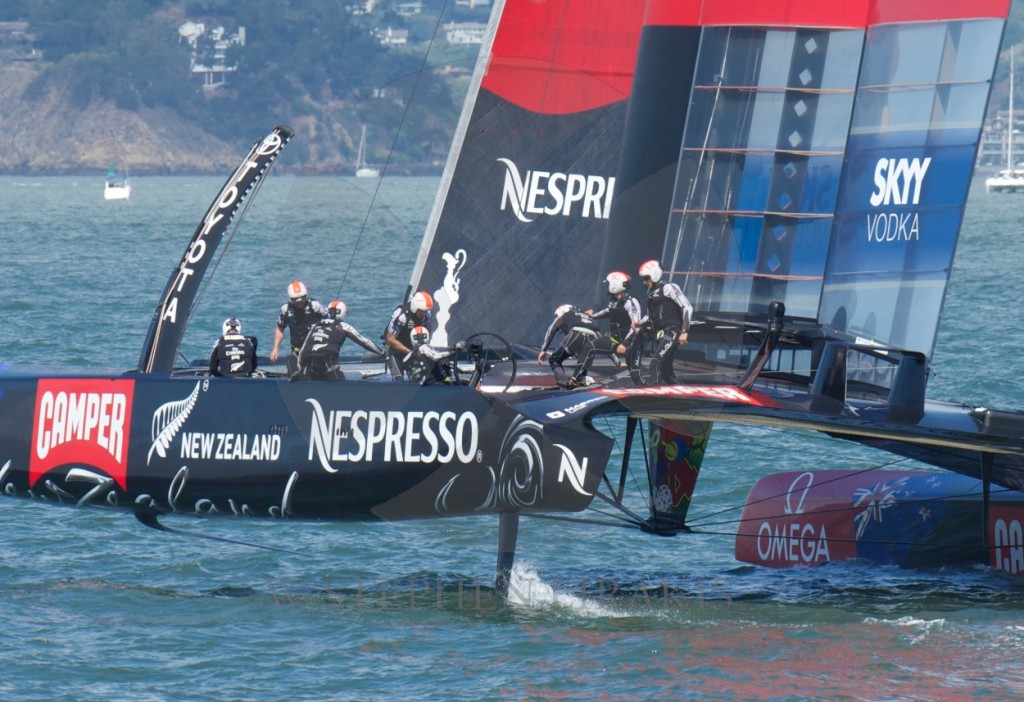
Everyone is wondering what today will bring. Has there been a shift in the momentum in favor of Oracle? Team New Zealand have had a very journeyman like approach to this event. Since it is more my personality; I can associate with this thinking; but anything can happen as we saw yesterday.
RACE 8
America’s Cup: Defender raises game, Kiwis fumble in Race 8
San Francisco, CA (September 14, 2013) – Well that was interesting. Just when we thought we’d seen it all, race eight of the 34th America’s Cup provided us something new. We saw defender Oracle Team USA have pace upwind, we saw challenger Emirates Team New Zealand almost capsize, and we saw the American team win by 52 seconds.
With 18 knots and an ebb tide American team skipper Jimmy Spithill was the aggressor in the prestart. He sought to hook the Kiwis and launch off the line to leeward, but the Kiwis timed the approach better to gain a 2 second lead.
The Kiwis guided the Americans down the leeward leg, but the defender kept it close, and were able to get a split at the leeward gate. The Kiwi’s 8 second lead was soon erased as the defender showed speed and tacking ability that had thus far been the Kiwi advantage.
“We’ve put in a lot of work to try and improve our boat and our tacks and our upwind speed,” said Spithill. “The shore team worked all day Friday with the design and engineering team, and I think we have taken a great step forward.”
The Kiwis were clearly pressured but barely held the lead on each cross. Crossing the defender on port, the Kiwis planned to tack in front and set up the final section of the upwind leg. “I was about to duck and try to hook them, but then when I saw them keep going we quickly got set up for a crash tack,” explained Spithill
What Spithill saw was a near capsize. The leeward foil popped the hull up in the turn, the wing failed to pop to the new tack, and with the starboard hull gaining altitude, the wind got under the boat and pushed it nearly over.
“When we rolled into the tack, we didn’t have the hydraulic pressure for the wing,” explained Barker. “If the wing doesn’t tack and the boat does, it leads to trouble. We got the hydraulics working about as late as you possibly could and fortunately the boat came back.”
Game…Set… Match
By the time the Kiwis recovered from their near accident, the defender was gone. A 27 second lead at the windward gate became a 47 second delta at the leeward gate, winning race 8 by 52 seconds.
So the question now is what more does the American team have in its speed toolkit. “There are still things we can change,” said Ben Ainslie, tactician for the defender. “We made some changes today that upped our performance. That’s the nature of this America’s Cup. It is a development race, and we will continue to push for changes that raise our performance.”
Click here for complete race stats.
Click here for all race reports.
Eight Completed Races – First team to 9 Points Wins
Emirates Team New Zealand: 6
Oracle Team USA: 0*
* Began series with -2 points due to International Jury penalty from AC World Series.
America’s Cup Final schedule
Saturday, Sept. 7: Race 1 (1:15 pm PT), Race 2 (2:15 pm PT)
Sunday, Sept. 8: Race 3 (1:15 pm PT), Race 4 (2:15 pm PT
Tuesday, Sept. 10: Race 5 (1:15 pm PT), Race 6 (2:15 pm PT); Race 6 postponed
Thursday, Sept. 12: Race 6 (1:15 pm PT), Race 7 (2:15 pm PT)
Saturday, Sept. 14: Race 8 (1:15 pm PT), Race 9 (2:15 pm PT)
Sunday, Sept. 15: Race 10 (1:15 pm PT), Race 11* (2:15 pm PT)
Monday, Sept. 16: Race 12* (1:15 pm PT)
Tuesday, Sept. 17: Race 13* (1:15 pm PT), Race 14* (2:15 pm PT)
Wednesday, Sept. 18: Reserve Day
Thursday, Sept. 19: Race 15* (1:15 pm PT), Race 16* (2:15 pm PT)
Friday, Sept. 20: Reserve Day
Saturday, Sept. 21: Race 17* (1:15 pm PT)
Sunday, Sept. 22: Reserve Day
Monday, Sept. 23: Reserve Day
– See more at: http://www.sailingscuttlebutt.com/2013/09/14/americas-cup-defender-raises-game-kiwis-fumble-in-race-8/#prettyPhoto














